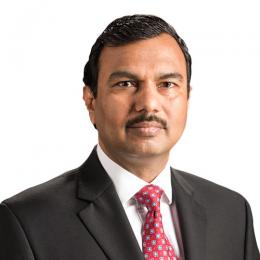At Big Four audit and advisory firm EY, data and analytics is generating rapid improvements in business processes and outcomes. EY’s IT organization is developing the technologies to inspect, cleanse, transform and model data in “three big buckets—for the audit and advisory services we provide, for our clients’ systems integration needs and for the needs of our 360,000 people worldwide,” said Global CTO Nicola Morini Bianzino.
EY’s IT organization is actually three IT organizations, each team focused on a particular bucket’s data and analytics needs. The technologies used by the three teams, however, is “similar, if not identical,” said Bianzino, an early AI pioneer who wrote a thesis on the application of neural networks to business in 1997. “We don’t segregate the technologies we build, and we encourage touchpoints between the three teams,” he said, estimating that about 2 million employee and client users run the firm’s suite of data analytics tools daily.

At public company SEI, CTO Sanjay Sharma’s IT organization also trifurcates the development and deployment of data and analytics tools. “We look at the technology as three different pillars—to enable internal innovations and insights, to ensure regulatory compliance and to provide data and analytic solutions to our clients,” he explained. SEI, with $1.4 billion in annual revenue, sells a range of customized investment solutions and enterprise wealth management services to asset managers, banks, wealth management firms and institutional investors.
Other CTOs and CIOs are on their own paths toward enabling data-driven insights across the enterprise, some using business intelligence software and others improving their decision-making based on machine learning algorithms. All are in hiring mode, recruiting data scientists and data architects to help pave a clearer business road ahead. Despite the different stages in their journeys, market realities require continuous momentum toward an end-state of deep analytical competencies.
“A business with great analytics capabilities lowers the cost of curiosity,” said Lou DiLorenzo, a managing director at Deloitte’s Strategy & Analytics practice and CIO Program leader. “By democratizing the data and analytics and having strong data governance standards and platforms in place, business questions are answered more quickly and accurately.”
Behind the scenes in creating and supervising the analysis of data across the business is the venerable IT organization. Not yesteryear’s IT organization, however. Having migrated from the back office to the front office a decade ago, modern IT teams now help functions like finance and accounting and sales and marketing source the data needed to answer their business-oriented questions. As Bianzino puts it, “No company can afford to keep tech in the back office anymore; if you don’t have people who can enable data and analytics, you will not serve your clients. You will fail.”
DiLorenzo agreed. “IT is positioned to look horizontally at every function’s needs,” he said, explaining that a big part of the job resume for IT professionals is “to engage with people in other functions in conversations about work that’s focused on data. The questions may be different, but the data set [informing the answers] is the same.”
What’s different are the analytics tools and the IT organization’s structure. “The data and analytics platform is sometimes provided by ecosystem partners or is built fit-for-purpose by the IT organization,” said DiLorenzo. “Some companies have a dedicated Chief Data Officer (CDO) with a separate data and technology team under the CDO that’s accountable for data integrity. Others have a CTO or a CIO responsible for the same.”
He added, “Every business is moving forward in the same direction, just at a different pace.”
Clearer Vistas Ahead
The pace of data and analytics enablement at Marvin Windows and Doors has picked up in the last few years. “Some IT organizations are sprinting down the path and others are dipping their toes in the water; we’re somewhere in between,” said Rob Orvis, Vice President of Technology at Marvin, a manufacturer of made-to-order wood, fiberglass and aluminum windows and doors, with approximately 7,000 employees and $1 billion in annual revenues.
Orvis is the top IT leader at Marvin, making him the equivalent of a CIO or CTO. In the four years he has served in this capacity, the company has become a data-driven organization. “Our job in IT is to ensure master data management, which entails three things—a single source of truth, wide-scale accessibility and data democratization, where everyone can harvest insights from multiple internal data sources, as well as external data provided by companies like our supply chain partners,” he said.
Assisting these needs is a cloud-computing data warehouse from provider Snowflake. “Our role in the IT organization is to create the capability to use the analytics effectively,” said Orvis. “We do this for two different stakeholders. Some functions want the analytical outcomes served up to them as a refined and finished product, whereas other functions want the data objects delivered in a catalog to personally apply the algorithms to their specific questions.” A data catalog is an organized inventory of a company’s data assets.
Asked which functions ask to have the data modeling done for them or prefer to do it themselves, Orvis said Marvin’s salesforce typically want the analytical insights “`quick and dirty,’ tailored to their particular needs,” while the operations and finance and accounting functions are more involved in “self-serve analytics.”
In either scenario, Marvin’s IT organization develops both the data catalog and the AI-generated analytical models. In doing the work, the company has doubled the number of data scientists and data architects in the last 12 months and plans to increase their ranks by 30 to 40 percent this year. “To fill in for the expertise we don’t yet have in-house, we rely on outside partners,” said Orvis, citing partnerships with Slalom, a builder of data platforms, dashboards and strategic AI solutions, and PhData, a provider of machine learning products and end-to-end data services.
Gaining Needed Traction
Other companies like Jack Henry & Associates are just beginning to formalize a more modern data and analytics approach. Rob Zelinka, CIO at the publicly traded technology company and payments processor with 6,770 employees, said the IT organization has embedded a business relationship manager within different functions to provide visibility into the data assisting their specific needs.
“We’ve made sure that sales, for instance, has a dashboard with visibility into the sales figures, and that finance has a dashboard with visibility into every line of business,” said Zelinka, adding that the IT team both creates and refines each dashboard. “We manage data well from an operational perspective, but we’re not leveraging new technology to move as quickly as we’d like. Sometimes the data is stale, outdated or lacks relevancy. To be fair, the vast amount of data we’re managing is overwhelming.” Jack Henry’s customers include more than 8,500 banks and credit unions.
The CIO is implementing the strategic changes needed to reach a new level of data and analytics maturity. “We’ve identified this as a gap and an opportunity,” he explained. “We’re at the outset of creating a new organizational structure in IT to support the outcomes we’re looking for. Analytics, machine learning and RPA (robotic process automation) are on our next-generation roadmap. But we need people to help drive and execute new solutions.”
Among these people is a new senior executive leader akin to a Chief Data Officer, whose remit is to develop the strategy guiding the next-generation roadmap. Once drafted, the data leader will be entrusted to hire needed data architects, data scientists and other specialized skill sets versed in data and analytics. In the meantime, Zelinka recently retained a third-party consultant to establish a new data governance model. “We’re building some momentum,” he said. “Our goal is to become a data-driven organization.”

Smaller businesses like Brainchild Communications Pakistan, a media services firm that is part of the French advertising agency Public Groupe, has the same objectives in mind. “We collaborate with providers of data like YouTube and Facebook to measure the impact of different digital, radio and outdoor advertisements,” said Rubab Rizvi, Data and Analytics Leader at Brainchild, which has about 500 employees at three offices across Pakistan’s main cities of Karachi, Lahore and Islamabad. “We then train people here in how to analyze Big Data using the BI tool in a media advertising context.”
The IT team uses a business intelligence tool from Qlik Sense to visualize customer data but is impeded by data quality issues in developing reliable insights. The “tricky part” with Pakistan’s advertising media data is the “many gaps,” which Rizvi said can produce outcomes that are untrustworthy. “It takes us at least a month to transform and clean the data to use the machine learning algorithms to make reliable predictions.”
Brainchild is training its IT staff on the cleansing of data prior to its use and the need for a robust set of data to enhance the integrity of the analytics outcome. “Implementing predictive analytics has been mostly `fail and learn’ for us,” Rizvi confided. “We require a minimum of 30 data points for statistical modeling, as per common methodologies.”
Despite these limitations, the IT team developed a successful predictive model for the beverage category last year. “It was a real breakthrough, increasing our confidence in the use machine learning algorithms on a more regular basis in the future,” she said.
In the Fast Lane
SEI and EY are well ahead in their trifurcated data and analytics strategies. Sharma, SEI’s CTO the past seven and one-half years and a senior vice president of IT since 2008, led the development of the firm’s wealth management platform, a single, unified solution serving the data and application needs of multiple stakeholders, including approximately 7,500 SEI financial advisors and users at over 50 banks.
He also created a seven-member Data and Analytics Center of Excellence (COE) within the IT organization, whose remit is to draw business insights from the platform. Before creating and populating the team, Sharma took an online course at Stanford University to receive a Certificate of Achievement in Machine Learning. He then reached out to the broader IT organization and asked who might be interested in learning about AI and data analytics. “I said, `Raise your hands and…we will send you to a 13-week bootcamp for training,’” he said.
Seventy people applied, of which 30 eventually were sent to the bootcamp, where the trainees worked on multiple use cases. In a subsequent hackathon, approximately 600 people in SEI’s operations decided which trainee use cases would receive corporate funding. The initial bootcamp was so successful, the COE has since hosted two additional ones.
“We now have 90 `citizen’ data scientists (across the IT organization),” Sharma said. “When I came here, we had zero lines of code for the wealth platform initiative and today we have over 70 million lines of code, which grows by the day. Such a very large, global and multi-tenant platform would not have been possible without the use of data and analytics.”
At EY, CTO Bianzino commented that his strategic priority is to position technology at the heart of the giant audit and advisory firm’s service lines and markets. Since joining EY in 2018 (he was previously responsible for defining Accenture’s global AI strategy), Bianzino has built an integrated global data and analytics infrastructure, architected to serve the firm’s expansive business model, assist the systems integration needs of clients and be a crucial factor in the business decisions of EY professionals, hence the three separate IT teams.

Despite the different use cases, the technology itself is created for all needs. Bianzino provided the example of the master data on EY customers, information that is useful for sales and marketing and finance and accounting functions, as well as for EY’s tax advisors and the firm’s own tax management needs. Although the data and analytics technologies used by the three IT teams is nearly identical, sameness is the desired state.
“We’re not yet 100 percent there but we’re close to building a common set of data and analytics tools across the three buckets,” Bianzino said. “The system then becomes more intelligent than the sum of the parts.” He added that from a technology investment standpoint, “When we examine a particular machine learning framework, for instance, we do it across the board. It doesn’t make sense from an organizational or a technical standpoint to have three separate investments.”
Nor does it make sense from a talent perspective to separate the teams as discrete entities. “There’s a bit of a stigma if you’re perceived as an `IT person’ as opposed to a technology consultant,” said Bianzino. “To obviate this possibility, I’m making sure we move people across the three teams, much like the firm moves non-IT people from one service area like tax to another service area like advisory.” These movements increase the breadth of individual skill sets and give teams a better understanding of the enterprise, its culture and goals. “The most successful people in an organization are those proven to be capable of working across businesses and geography,” said Bianzino. “The knowledge that is stored in people’s brains here is astounding.”









